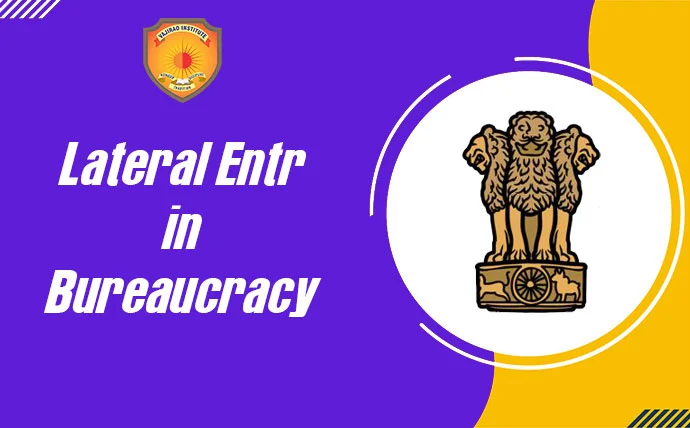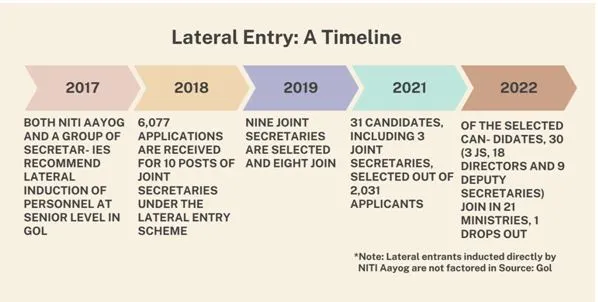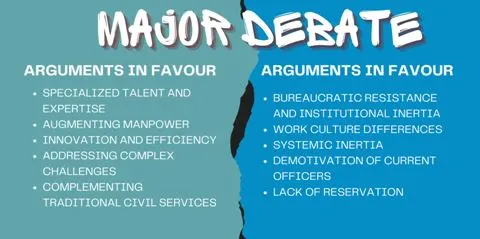
Lateral Entry:
It refers to the process of hiring people from other different disciplines outside the conventional disciplined based government service categories to occupy mid and senior cadre positions in the government departments. In other words, it is as if new entrants of individuals into the govt. departments with special knowledge and experiences from other sectors say, academia, private or PSUs, are encouraged to bring in their expertise into governance and policy formulation.

Origin:
- Originally, the lateral entry was proposed during Prime Minister Narendra Modi’s government and the first vacancies were shared in 2018.
- However lateral entry not something new. It was formerly suggested by the Second ARC which was set up in 2005 during the United Progressive Alliance (UPA) government headed by the Indian National Congress party.
- The ARC noted the fact that there was need to introduce specialized expertise through civil service to warrant quality formulation and the implementation of policies. ARC has supported the idea of lateral entry as one way out of these many governance issues.
Recruitment Process:
- Those successful in the lateral entry process are normally offered contracts meant to last from 3-5 years with options to renew depending on performance.
- Some of these posts are joint secretary, director and deputy secretary at the ministries of Union Government of India.
- Applicant’s profile is from state/UT government organizations, PSUs, statutory bodies, research establishments, universities and autonomous organizations, and private organizations.
Role of UPSC in the process
- The UPSC is supposed to conduct selection process in order to fill the lateral entry positions.
- Ministries, departments, PSUs and autonomous bodies – who wish to recruit mid and senior level employees through lateral entry – liaise with the UPSC.
- These positions are filled through applications made online and the candidates are assessed on the basis of their experience and suitability for the particular position in the government.
- With the Trust in UPSC’, the Indian government targets at improving the efficacy of bureaucracy.
- The UPSC’s mandate is to provide information to the government through which recruitment is done and to enable the identification of competent people in the achievement of governance and policy implementation.
Eligibility Criteria:
The people with a background in a specific functional area of operation and with experience in a given field are eligible.These eligible candidates can come from:
- Private sector: Experts who, having received specific knowledge within the frames of private organizations, have already had their practical experience.
- State governments: Persons with previous working experience in the administration of state governments.
- Autonomous bodies: From research institutes, universities and other autonomous organizations.
- Public sector undertakings (PSUs): Those people who have worked for government organizations or have been in the government-owned businesses.

Major Debate:-
a. Merit vs. Reservation:
- As much as merit helps in making sure that talented people do deliver as expected equal opportunity does not mean equal opportunities because people start from different backgrounds.
- Reservation makes sure that the minority gets an opportunity to be part of the decision-making structures, defeats the system of selective formation of the teams by the elites.
- Unreservedly, it can be forecasted that the proportion of SCs and STs in the higher bureaucratic positions may decline causing deep marginalization of these groups.
b. Effectiveness of Lateral Entry:
- Employees agree stating that lateral entry introduces new ideas and professional bias that is relevant in contemporary administration.
- Critics have it that if allowed without reservation, lateral entry is likely to lock out certain categories of people in society and thus defeat the rationale for social justice.
c. Balancing Expertise and Social Justice:
As such the difficulty is to strike a balance between going specialized and going social justice.
d. Representation Challenges:
- However, like all things that present opportunities in addressing the leadership shortage and development, lateral entry has issues of representation.
- The representation of the SCs and STs, which are the marginalized sections of the society, is dampened in the higher civil service.
Arguments in Favour:-
1. Specialized Talent and Expertise:
- Proponents argue that someone who enters the civil services at a point other than the initial level can introduce new ideas and unique skills into the services.
- The government can supplement its human capital from personnel with background in other disciplines across the technology, economics and management disciplines amongst others.
- Just think of having specialists, who are familiar with such technologies as cloud computing, data analysis, or project management, contribute to shaping policies and actually implement them. They can even prove to be very helpful at times.
2. Augmenting Manpower:
- Since lateral entrants come to the organization from a different department, therefore they possess deep knowledge of the area they come from.
- Bringing them into the bureaucracy meets the twin objectives of:
- Bringing in fresh talent: It also brings fresh ideas and approaches to the system which is important for any organization to adapt to change.
- Augmenting the availability of manpower: Particularly in cases where the incumbents may not possess the specific expertise needed for the task at hand as is often the case of career civil servants.
3. Innovation and Efficiency:
- The private sector, academia and non-profits organisations each work on a different paradigm and they are more inclined towards innovation.
- In this sense, lateral entry gives stake holders from these sectors a chance to be involved in governance.
- Having new ideas, integrated time management and innovative approaches they can influence more positive impact for the citizens.
4. Addressing Complex Challenges:
- Today governance is much more complex – climate change, digitalisation, or pandemics are challenges of any governance.
- As for the following challenges, lateral entrants have the expertise to address them directly.
- For instance, the government of India can hire a more experienced cyber security expert to boost India’s digital security services.
5. Complementing Traditional Civil Services:
- Lateral entry is actually an addition to the civil services and therefore does not assume the place of the civil services.
- Closely related to the above argument, it helps overcome gaps by introducing a set of skills that are not inherent to the bureaucratic setting.
- This interaction between career civil servants and lateral entrants can put into operation a more efficient government.
Arguments Against:-
1. Bureaucratic Resistance and Institutional Inertia:
- This is because civil servants who were appointed have served for a long time in the civil service, and may not be comfortable with competition from lateral entrants.
2. Work Culture Differences:
- Bureaucratic work culture is quite peculiar. It has its own set of working culture that includes certain set principles, standards or regulations.
- The novices from the outside or young and bright employees coming from civil services, private sector or any academic institution may have difficulty in this culture. Sometimes, however, this transition is not too smooth.
- That is why even daily interactions may cause conflicts because people have different working methods, make decisions differently, and communicate in various ways.
3. Systemic Inertia:
- One drawback of bureaucracy is that is never positively inclined to change. It is not as responsive as a fishing boat; it is more compared to a large ship- it turns slowly.
- The incumbents can pose some challenges once the lateral entrant seeks to change the system or bring about reformation.
- However, strong established routines may act as a barrier to change since it becomes difficult for organisations to increase the speed of innovation and responsiveness.
4. Demotivation of Current Officers:
- The use of lateral entrants is also a good practice when they are recruited at mid-levels because it disrupts the staffing of officers.
- Certain current officers may get discouraged, more so, if the lateral entrants are assumed to be joining at a higher rank.
- This demotivation could affect the employees’ performance and general productivity, thus acting as a hindrance towards the achievement of the organization’s goals.
5. Lack of Reservation:
- One of the areas of major concern is one which has to do with lack of reservation and constraint on lateral entry.
- The oppressed class in the Indian context includes particulars belonging to the Scheduled castes (SC) and Scheduled tribes (ST), most of whom has been denied education and other opportunities.
- With equal certainty, the threat is that lateral entry will worsen the lack of satisfactory representation of the above mentioned groups in decision making positions.
Way Forward
- Sensitization Programs: One must agree that resistance from traditional civil service cadres is likely to be a stumbling block towards lateral entrants; however, resistance can be overcome by creating awareness and increasing cadres’ sensitivity to the program. Promote forums that will enhance the need for diverse representation in decision-making processes. Caution that lateral entry serves to augment civil services, and not compete with them.
- Transparency and Consultation: India has to move away from the top down approach. Bring more accountability while proceeding with decision-making process, making appointments and transfers in civil services.
- Balancing Merit and Social Justice: It is more important to discuss about merit and reservation. As much as merit-based selection is important, equal opportunities do not translate into equal chances because of the disparities in the starting point and Reservation guarantees the right of some groups to make decisions, thereby reducing the monopoly of other groups.
- Skill Enhancement and Adaptation: lateral entrants require certain kinds of support to perform in organization with bureaucratic work culture. This support can bring a positive attitude and help for better adaptation.Orientation programs must be conducted with new employees helping them know acceptable standards, procedures as well as communication.
- Monitoring and Evaluation: It is suggested that one should conduct a periodic evaluation on lateral entry to determine its effectiveness. In the same manner, measure the efficiency and effectiveness of lateral entrants in the given organization and how they influenced the policies set and in general, the results.